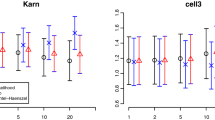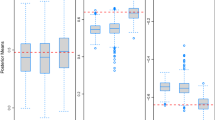Abstract
We consider the situation with a survival or more generally a counting process endpoint for which we wish to investigate the effect of an initial treatment. Besides the treatment indicator we also have information about a time-varying covariate that may be of importance for the survival endpoint. The treatment may possibly influence both the endpoint and the time-varying covariate, and the concern is whether or not one should correct for the effect of the dynamic covariate. Recently Fosen et al. (Biometrical J 48:381–398, 2006a) investigated this situation using the notion of dynamic path analysis and showed under the Aalen additive hazards model that the total effect of the treatment indicator can be decomposed as a sum of what they termed a direct and an indirect effect. In this paper, we give large sample properties of the estimator of the cumulative indirect effect that may be used to draw inferences. Small sample properties are investigated by Monte Carlo simulation and two applications are provided for illustration. We also consider the Cox model in the situation with recurrent events data and show that a similar decomposition of the total effect into a sum of direct and indirect effects holds under certain assumptions.
Similar content being viewed by others
References
Aalen OO (1980) A model for nonparametric regression analysis of counting processes. In: Mathematical statistics and probability theory (Proceedings of the Sixth International Conference, Wisła 1978). Lecture Notes in Statistics, vol 2. Springer, New York, pp 1–25
Aalen OO (1989) A linear regression model for the analysis of life times. Stat Med 8: 907–925
Aalen OO (1993) Further results on the non-parametric linear regression model in survival analysis. Stat Med 12: 1569–1588
Cole SR, Hernán MA (2002) Fallibility in estimating direct effects. Int J Epid 31: 163–165
Cox DR (1972) Regression models and life tables. J Roy Stat Soc B Stat Meth 34: 406–424
Fosen J, Borgan Ø, Weedon-Fekjær H, Aalen OO (2006) Dynamic analysis of recurrent event data using the additive hazard model. Biometrical J 48: 381–398
Fosen J, Ferkingstad E, Borgan Ø, Aalen OO (2006) Dynamic path analysis—a new approach to analyzing time-dependent covariates. Lifetime Data Anal 12: 143–167
Goetgeluk S, Vansteelandt S, Goetghebeur E (2009) Estimation of controlled direct effects. J Roy Stat Soc B Stat Meth 70: 1049–1066
Kalbfleisch JD, Prentice RL (2002) The statistical analysis of failure time data. Wiley, New York
Kristensen K, McGue M, Petersen I, Jeune B, Vaupel JW (2008) Exceptional longevity does not result in excessive leves of disability. Proc Natl Acad Sci USA 105: 13274–13279
Lin DY, Wei LJ, Ying Z (1993) Checking the Cox model with cumulative sums of martingale-based residuals. Biometrika 80: 557–572
Lin DY, Wei L, Yang I, Ying Z (2000) Semiparametric regression for the mean and rate functions of recurrent events. J Roy Stat Soc B Stat Meth 62: 711–730
Martinussen T, Keiding N (1997) The Manton-Woodbury model for longitudinal data with dropouts. Stat Med 16: 273–283
Martinussen T, Scheike TH (1999) A semi-parametric additive regression model for longitudinal data. Biometrika 86: 691–702
Pearl J (2001) Direct and indirect effects. In: Proceedings of the seventeenth conference of uncertainty in artificial intelligence. Morgan Kaufmann, San Francisco, CA, pp 411–420
Rao CR (1973) Linear Statistical inference and its applications. Wiley, New York
Robins JM (1999) Testing and estimation of direct effects by reparameterizing directed acyclic graphs with structural nested models. In: Glymour C, Cooper G (eds) Computation and causation, and discovery. AAAI Press/The MIT Press, Cambridge, MA, pp 349–405
Robins JM, Greenland S (1992) Identifiability and exchangeability for direct and indirect effects. Epidemiology 3: 143–155
Scheike TH (2002) The additive nonparametric and semiparametric Aalen model as the rate function for a counting process. Lifetime Data Anal 8: 247–262
Schlichting P, Christensen E, Andersen P, Fauerholds L, Juhl E, Poulsen H, Tygstrup N (1983) The Copenhagen study group for liver diseases. Hepatology 3: 889–895
Spiekerman CF, Lin DY (1998) Marginal regression models for multivariate failure time data. J Am Stat Assoc 93: 1164–1175
Struthers CA, Kalbfleisch JD (1986) Misspecified proportional hazard models. Biometrika 73: 363–369
Wright S (1934) The method of path coefficients. Ann Math Stat 5: 161–215
Author information
Authors and Affiliations
Corresponding author
Rights and permissions
About this article
Cite this article
Martinussen, T. Dynamic path analysis for event time data: large sample properties and inference. Lifetime Data Anal 16, 85–101 (2010). https://doi.org/10.1007/s10985-009-9128-2
Received:
Accepted:
Published:
Issue Date:
DOI: https://doi.org/10.1007/s10985-009-9128-2




